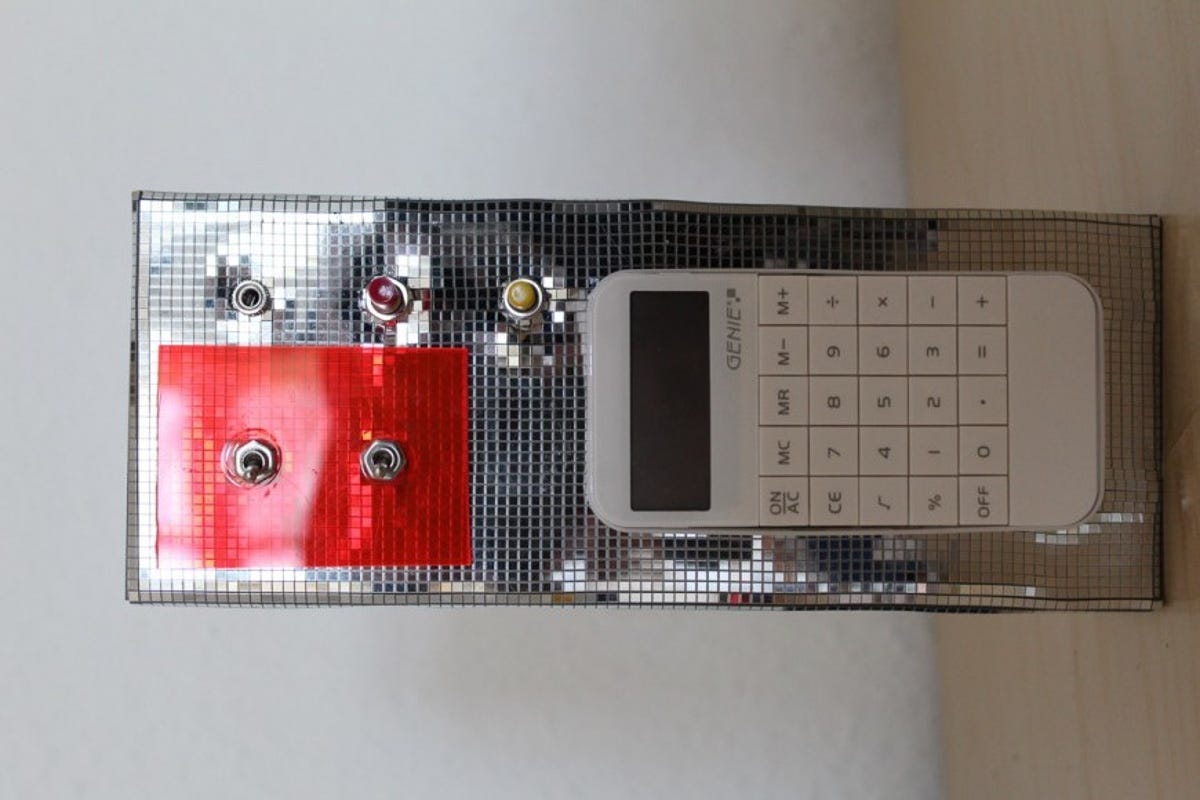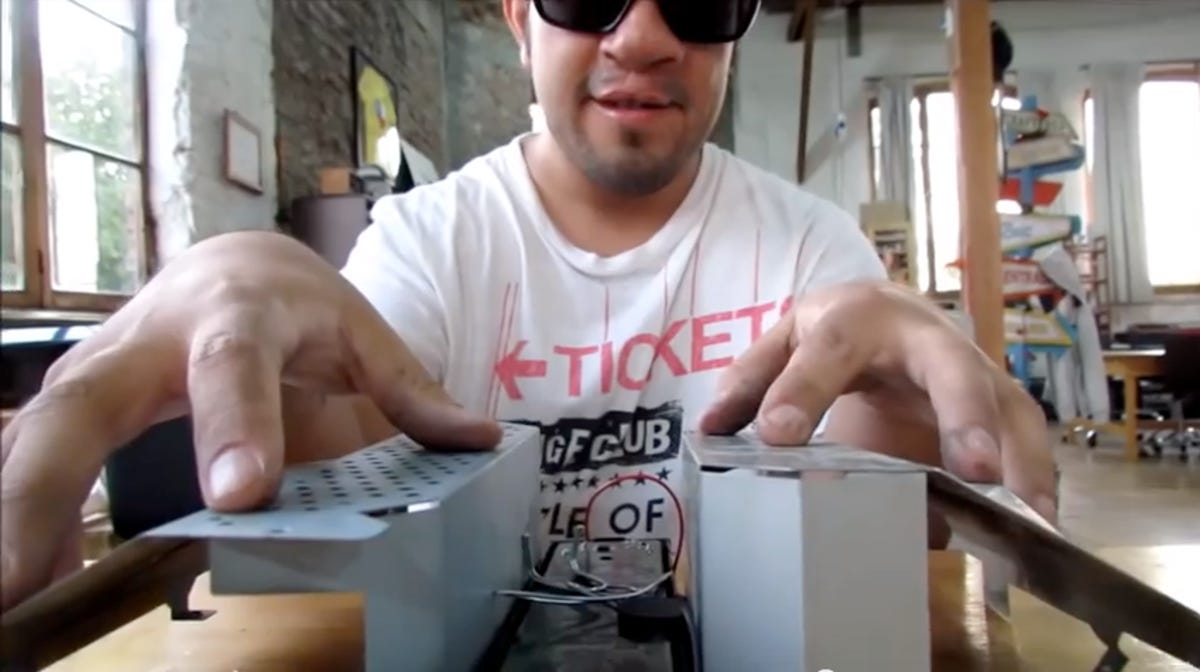Singing helmets and robot crickets: Weird music mods from Moogfest (pictures)
There were plenty of awesome electronic instruments played at Moogfest this year. From a calculator to an old Atari console, check out these creative entries in the festival's annual circuit-bending contest.

A different kind of music
The concept of circuit bending -- altering the internal circuits of electronic devices like keyboards, drum machines, and kids' toys to create new musical instruments -- was first conceived by Reed Ghazala in 1966 when he noticed that a short-circuiting toy amp in his desk was making sounds.
Since then, circuit bending has become a core part of the culture of electronic tinkerers, and Ghazala himself has created experimental instruments for world-class musicians like Peter Gabriel and Tom Waits.
To celebrate this unique way of creating instruments, Moogfest -- a festival of electronic arts and music held regularly in Asheville, N.C. -- launched a circuit-bending competition. The rules this year were simple: competitors could spend only up to $70 and the "bent" instrument had to be battery-powered.
This device, by entrant Rebecca Baxter, beat that budget by $50, coming in at just $20 for parts. It uses a simple "Genie" pocket calculator as its input device and, through the use of two capacitors, some wire, switches, and an audio jack, it turns boring numerical inputs into sweet synth sound.
Find out more about this Moogfest 2014 circuit-bending entry here.

Deranged robotic crickets
This entry from the Drunkard Crickets, a self-described "group of Chilean circuit benders," turns the infrared output of a Sony TV remote control into sounds that you activate by placing your hands on or near the metal plates. The device, which does in fact make sounds like the plaintive song of a pack of deranged robotic crickets, also came in way under budget, costing just $20 for the remote, speaker, cable, and battery (excluding the cost of the metal plates, which were recycled).
Find out how to build your own instrument from a TV remote control here.
Bending a toy guitar
If you think you need an engineering degree to create your own circuit bends, this project could change your mind. It was created using a Kawasaki toy guitar, and in the instructions on how to make your own, the inventor, who names himself only as Trazmick (or Connor in his video), says, "Take your gator clips and poke around on the circuit board(s) while triggering sounds by pressing some of the toy's buttons. Listen for anything weird or that sounds good. When you find a bend or any new connection between two points on the circuit board that makes a cool, new sound, clip the gator clips to that point on the circuit board and experiment by placing a potentiometer between the two points. Try and find a pot that controls the effect of the bend. Try placing switches between the bend as well to be able to turn the bend on and off. "
So basically, just wire things together till you get a sound you like and make those connections permanent. Sounds like something most of us could handle, eh?
More pictures and information on the toy guitar bend here.
'Play' Atari, literally
Stephen Barnwell, a student from North Carolina State University's Mechatronics program in Moogfest's home city of Asheville, N.C., created his circuit bend with the goal of adding a visual element to the device. So he mashed up an old Atari 2600 video game console with a cheap Casio keyboard to create what he has called his "Cataritone" – a device that morphs the video output of classic Atari games in accordance with what someone plays on the keyboard. His creative mod earned him fourth place in the competition.
Get more details on the Cataritone here.
Sizzling tool holder
California native Mike Sisk pulled a variety of elements together to create his bend, which earned him third place in the competition. His device is created from a toy Kawasaki/Remco electric guitar, a toy voice changer, and a kid's cassette player. The case in which he neatly arranged all these components spent its former life as a barbecue tool holder. Although his device only garnered him a third-place win, the judges felt that the way in which he neatly packaged such a disparate collection of gear could serve as a model for other benders in the future.
See Sisk's video here.
Compose while biking
Actually, calling this invention simply "helmet bend" does it a disservice. The real name chosen by its maker is: "C. Freddi's Super Sonic Circuit Bending Helmet: A Reflective, Transmodern Statement on The Creative Culture of Hardware Hacking, The Socioeconomic and Environmental Necessity of Using Sustainable Resources, and The Nature and Extent of Interactivity and Community Influence, 2014."
It was the only one of the finalists that could be worn, and that no doubt helped propel it into second place.
The device is made from a modified Yamaha QY-10t MIDI sequencer and employs a helmet-mounted microphone to convert voice input into fuzzy synthesized sound.
Find out more from C. Freddi's entry videos part one, two, and three.
Keyboard grows (and glows) up
To make his grand-prize-winning circuit bend, George Gleixner, a 23-year-old University of Virginia graduate, started with a Hing Hon EK-001, a small Chinese-built children's keyboard. To this he added a large plexiglass control panel containing a series of bends, including distortions, glitches, various modulations, three low-frequency oscillators, video inputs and outputs, and the coolest part of all -- optical theremins to give the machine that real sci-fi sound.
Check out his whole process here.

